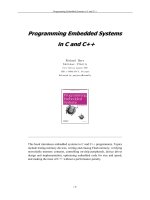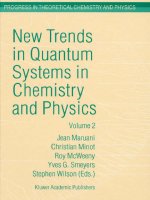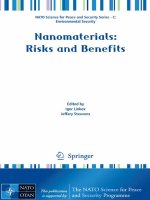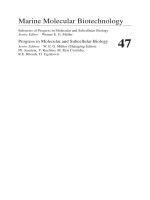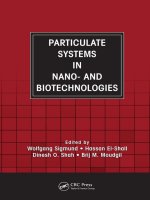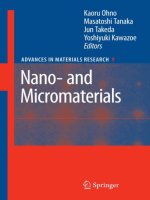- Trang chủ >>
- Khoa Học Tự Nhiên >>
- Vật lý
particulate systems in nano- and biotechnologies, 2009, p.426
Bạn đang xem bản rút gọn của tài liệu. Xem và tải ngay bản đầy đủ của tài liệu tại đây (16.04 MB, 426 trang )
PARTICULATE
SYSTEMS
IN
NANO- AND
BIOTECHNOLOGIES
7436_C000.indd 1 11/15/08 12:21:06 PM
7436_C000.indd 2 11/15/08 12:21:07 PM
CRC Press is an imprint of the
Taylor & Francis Group, an informa business
Boca Raton London New York
Edited by
Wolfgang Sigmund • Hassan El-Shall
Dinesh O. Shah • Brij M. Moudgil
PARTICULATE
SYSTEMS
IN
NANO- AND
BIOTECHNOLOGIES
7436_C000.indd 3 11/15/08 12:21:07 PM
CRC Press
Taylor & Francis Group
6000 Broken Sound Parkway NW, Suite 300
Boca Raton, FL 33487-2742
© 2009 by Taylor & Francis Group, LLC
CRC Press is an imprint of Taylor & Francis Group, an Informa business
No claim to original U.S. Government works
Printed in the United States of America on acid-free paper
10 9 8 7 6 5 4 3 2 1
International Standard Book Number-13: 978-0-8493-7436-4 (Hardcover)
This book contains information obtained from authentic and highly regarded sources. Reasonable
efforts have been made to publish reliable data and information, but the author and publisher can-
not assume responsibility for the validity of all materials or the consequences of their use. The
authors and publishers have attempted to trace the copyright holders of all material reproduced
in this publication and apologize to copyright holders if permission to publish in this form has not
been obtained. If any copyright material has not been acknowledged please write and let us know so
we may rectify in any future reprint.
Except as permitted under U.S. Copyright Law, no part of this book may be reprinted, reproduced,
transmitted, or utilized in any form by any electronic, mechanical, or other means, now known or
hereafter invented, including photocopying, microfilming, and recording, or in any information
storage or retrieval system, without written permission from the publishers.
For permission to photocopy or use material electronically from this work, please access www.copy-
right.com ( or contact the Copyright Clearance Center, Inc. (CCC), 222
Rosewood Drive, Danvers, MA 01923, 978-750-8400. CCC is a not-for-profit organization that pro-
vides licenses and registration for a variety of users. For organizations that have been granted a
photocopy license by the CCC, a separate system of payment has been arranged.
Trademark Notice: Product or corporate names may be trademarks or registered trademarks, and
are used only for identification and explanation without intent to infringe.
Library of Congress Cataloging-in-Publication Data
Particulate systems in nano- and biotechnologies / editors, Wolfgang Sigmund …
[et al.].
p. cm.
Includes bibliographical references and index.
ISBN 978-0-8493-7436-4 (alk. paper)
1. Nanoparticles. 2. Biotechnology. 3. Nanotechnology. I. Sigmund, Wolfgang.
II. Title.
TP248.25.N35P54 2008
660.6 dc22 2008043505
Visit the Taylor & Francis Web site at
and the CRC Press Web site at
7436_C000.indd 4 11/15/08 12:21:07 PM
v
Contents
Preface vii
Editors ix
Contributors xiii
Chapter 1 Particle Technology—Then and Now—A Perspective 1
R. Davies
Chapter 2 The Production of Nanoparticles: The “Top-Down” Approach,
with Emphasis on Aerosol Routes, Especially
Electrohydrodynamic Atomization 15
J.C.M. Marijnissen, J. van Erven, and K J. Jeon
Chapter 3 Use of Self-Assembled Surfactants
for Nanomaterials Synthesis 27
M. Andersson, A.E.C. Palmqvist, and K. Holmberg
Chapter 4 Synthesis and Engineering of Polymeric Latex Particles for
Hemodialysis
Part I—A Review 53
S. Kim, H. El-Shall, R. Partch, and B. Koopman
Chapter 5 Synthesis and Engineering of Polymeric Latex Particles for
Hemodialysis
Part II—An Experimental Study 85
S. Kim, H. El-Shall, R. Partch, T. Morey, and B. Koopman
Chapter 6 Product Engineering of Nanoscaled Materials 115
W. Peukert and A. Voronov
Chapter 7 Surface Engineering Quantum Dots at the Air-Water Interface 137
J. Orbulescu and R.M. Leblanc
Chapter 8 Fundamental Forces in Powder Flow 165
N. Stevens, S. Tedeschi, M. Djomlija, and B. Moudgil
7436_C000.indd 5 11/15/08 12:21:07 PM
vi Contents
Chapter 9 Characterization of Pharmaceutical Aerosols and Dry Powder
Inhalers for Pulmonary Drug Delivery 193
M.S. Coates, P. Tang, H K. Chan, D.F. Fletcher, and J.A. Raper
Chapter 10 Imaging of Particle Size and Concentration in Heterogeneous
Scattering Media Using Multispectral Diffuse Optical
Tomography 223
C. Li and H. Jiang
Chapter 11 Surfactants /Hybrid Polymers and Their Nanoparticles for
Personal Care Applications 241
P. Somasundaran and P. Deo
Chapter 12 FloDots for Bioimaging and Bioanalysis 255
G. Yao, Y. Wu, D.L. Schiavone, L. Wang, and W. Tan
Chapter 13 Photocatalytic Particles for Biocidal Applications 283
G. Pyrgiotakis and W. Sigmund
Chapter 14 Zero-valent Iron Nanoparticles for Abatement of
Environmental Pollutants
Materials and Engineering Aspects 309
X Q. Li, D.W. Elliott, and W X. Zhang
Chapter 15 Functionalized Magnetite Nanoparticles—Synthesis,
Properties, and Bioapplications 331
P. Majewski and B. Thierry
Chapter 16 The Emergence of “Magnetic and Fluorescent” Multimodal
Nanoparticles as Contrast Agents in Bioimaging 353
P. Sharma, A. Singh, S.C. Brown, G.A. Walter, S. Santra,
S.R. Grobmyer, E.W. Scott, and B. Moudgil
Index 393
7436_C000.indd 6 11/15/08 12:21:07 PM
vii
Preface
With the explosion of opportunities in nano-biotechnology, the scope of particle
technology has acquired a new focus on soft particulate (bacteria, viruses, cells,
droplets) systems and adsorbed lms. Considering that these (soft) particles are
highly sensitive to temperature and shear forces, new protocols for their synthesis,
characterization, processing and handling must be developed to enable timely appli-
cations. Complexity and lack of understanding of multiphase systems have led to
inefcient utilization of particulate materials, especially for nano-bio applications.
Nano-bio advances are further complicated by the lack of adequate education of
engineers and scientists in particle science and technology, especially at the nano-bio
interface including the eld of adsorbed lms.
This volume embodies in part the advances presented at the International
Symposium on the Role of Adsorbed Films and Particulate Systems in Nano and
Biotechnologies held in Gainesville, Florida, August 24–26, 2005. This symposium
was organized to celebrate the successes of the Particle Engineering Research Center
(PERC) during its 11 year funding by the National Science Foundation (NSF) under
grant numbers EEC-94-02989 and BES/9980795. This book summarizes the most
exciting advances in adsorbed lms and particulate systems over the last decade.
Select researchers including Plenary and Invited symposium speakers were asked to
write review papers on the advances that were achieved worldwide in this exciting
eld. These experts represent the European, Austral-Asian as well as the Americas
leading Particle and Nano-Bio research centers.
Among the topics covered in this volume are: overview of particle technology
now and then, production of nanoparticles by top-down approach, self-assembled
surfactants for nonmaterial synthesis, engineering of polymeric latex particles for
hemodialysis, product engineering of nanoscaled materials, surface engineering of
quantum dots, fundamental forces in powder ow, pharmaceutical aerosols, inhal-
ers for pulmonary drug delivery, imaging of particle size and concentration in het-
erogeneous scattering media, surfactants/hybrid polymers and their nanoparticles
for personal care applications, FloDots for bioimaging and bioanalysis, particles for
biocidal applications, iron nanoparticles for abatement of environmental pollutants,
functionalized magnetite nanoparticles, multimodal nanoparticles as contrast agents
in bioimaging.
We trust that both the established as well as those embarking on their maiden
research voyage in this important eld will nd this treatise valuable.
We are grateful to the authors for their interest, enthusiasm, and contributions,
without which this book would not have been possible. We are thankful to faculty
members, postdoctoral associates, graduate students and administrative staff of
both the Particle Engineering Research Center (PERC) and the Center for Surface
7436_C000.indd 7 11/15/08 12:21:07 PM
viii Preface
Science and Engineering, University of Florida for their valuable assistance during
the symposium and in nalizing the drafts. We acknowledge the generous support
of the following organizations: the National Science Foundation, the University of
Florida, and the Industrial Partners of the Particle Engineering Research Center.
Finally, we thank the editing and production staff at CRC/Taylor and Francis for
their valued assistance.
Wolfgang Sigmund
Hassan El-Shall
Dinesh O. Shah
Brij M. Moudgil
7436_C000.indd 8 11/15/08 12:21:07 PM
ix
Editors
Dr. Sigmund is Professor of Materials Science and Engineering at the University
of Florida. He has been at UF since 1999 coming from the Max-Planck Institute
of Metals Research and University of Stuttgart. He is editor-in-chief of the journal
Critical Reviews of Solid State and Materials Sciences and an elected member of the
European Academy of Sciences.
Wolfgang Sigmund
University of Florida
Department of Materials Science & Engineering
.edu
Dr. El-Shall is Associate Professor of Materials Science and Engineering and
Associate Director for Research at The Particle Engineering Research Center of
University of Florida. He has been at UF since 1994. He also served as Associate
7436_C000.indd 9 11/15/08 12:21:08 PM
x Editors
Director for Beneciation Research at the Florida Institute of Phosphate Research
from 1986-1992. He co-edited six books related to phosphate processing. He serves
as an editor and reviewer for several archival Journals.
Hassan El-Shall
University of Florida
Department of Materials Science & Engineering
.edu
Dinesh O. Shah is Professor Emeritus and Founding Director (1984–2008) of the
Center for Surface Science and Engineering at University of Florida. He was the
First Charles Stokes Professor in Chemical Engineering Department. He served as
a joint faculty member in the Department of Chemical Engineering and Department
of Anesthesiology, working on interfacial phenomena in engineering and biomedi-
cal systems. He has been a recipient of several awards for excellence in teaching,
research and scholarship over the past four decades. He is among the top one per-
cent of most frequently cited scientists in the world. He has published widely in the
areas of monolayers, foams, macro-and microemulsions, and surface phenomena in
contact lenses, membranes, lungs and anesthesia. He was a thrust leader for nano-
bio systems in the particle engineering research center. He has edited 11 books and
monographs and has published about 250 papers.
Dinesh O. Shah
University of Florida
Department of Chemical Engineering and
Department of Anesthesiology
.edu
7436_C000.indd 10 11/15/08 12:21:09 PM
Editors xi
Brij M. Moudgil is a Distinguished Professor and Alumni Professor of Materials
Science and Engineering at the University of Florida. He is also serving as the
Director of the Particle Engineering Research Center. His research interests are
in polymer and surfactant adsorption, dispersion and aggregation of ne particles,
nanotoxicity, multifunctional nanoparticles for bioimaging, diagnosis, and therapy,
nanoparticulate processing and separation technology for enhanced performance
in mineral, chemical, microelectronics, pharmaceutics, advanced materials, and
resource recovery & waste disposal applications. He received his B.E degree in
Metallurgical Engineering from the Indian Institute of Science, Bangalore, India
and his M.S and Eng.Sc.D degrees from the Columbia University, New York, NY.
He has published more than 300 technical papers and has been awarded 14 patents.
He has been recognized by his peers with several professional awards. In 2002 he
was elected as a member of the U.S National Academy of Engineering. He can be
reached at .edu.
Brij M. Moudgil
University of Florida
Department of Materials Science & Engineering
.edu
7436_C000.indd 11 11/15/08 12:21:09 PM
7436_C000.indd 12 11/15/08 12:21:09 PM
xiii
R. Davies
Particle Engineering Research Center
University of Florida
Gainesville, Florida
J.C.M. Marijnissen
Delft University of Technology
Department of Chemical Technology
Particle Technology Group
Delft, The Netherlands
J. van Erven
Delft University of Technology
Department of Chemical Technology
Particle Technology Group
Delft, The Netherlands
K J. Jeon
Department of Environmental
Engineering Sciences
University of Florida
Gainesville, Florida
M. Andersson
Department of Applied Surface Chemistry
Chalmers University of Technology
Göteborg, Sweden
A.E.C. Palmqvist
Department of Applied Surface Chemistry
Chalmers University of Technology
Göteborg, Sweden
K. Holmberg
Department of Applied Surface Chemistry
Chalmers University of Technology
Göteborg, Sweden
S. Kim
Materials Science and Engineering
University of Florida
Gainesville, Florida
H. El-Shall
Particle Engineering Research Center
Materials Science and Engineering
University of Florida
Gainesville, Florida
R. Partch
Department of Chemistry
Clarkson University
Potsdam, New York
B. Koopman
Environmental Engineering Sciences
University of Florida
Gainesville, Florida
T. Morey
Anesthesiology, College of Medicine
University of Florida
Gainesville, Florida
W. Peukert
Institute of Particle Technology
University of Erlangen
Germany
A. Voronov
Coatings and Polymeric Materials
North Dakota State University
Fargo, North Dakota
J. Orbulescu
Department of Chemistry
University of Miami
Coral Gables, Florida
Contributors
7436_C000.indd 13 11/15/08 12:21:09 PM
xiv Contributors
R.M. Leblanc
Department of Chemistry
University of Miami
Coral Gables, Florida
N. Stevens
Particle Engineering Research Center
Materials Science and Engineering
University of Florida
Gainesville, Florida
S. Tedeschi
Particle Engineering Research Center
Materials Science and Engineering
University of Florida
Gainesville, Florida
M. Djomlija
Department of Chemical Engineering
University of Florida
Gainesville, Florida
B. Moudgil
Particle Engineering Research Center
Materials Science and Engineering
University of Florida
Gainesville, Florida
M.S. Coates
Faculty of Pharmacy
School of Chemical and Biomolecular
Engineering
University of Sydney
Australia
P. Tang
Faculty of Pharmacy
University of Sydney
Australia
H K. Chan
Faculty of Pharmacy
University of Sydney
Australia
D.F. Fletcher
School of Chemical and Biomolecular
Engineering
University of Sydney
Australia
J.A. Raper
Department of Chemical & Biological
Engineering
University of Missouri-Rolla
Rolla, Missouri
C. Li
Department of Biomedical Engineering
University of Florida
Gainesville, Florida
H. Jiang
Department of Biomedical Engineering
University of Florida
Gainesville, Florida
P. Somasundaran
Center for Advanced Studies in Novel
Surfactants
Langmuir Center for Colloid
and Interfaces
Columbia University
New York, NewYork
P. Deo
Center for Advanced Studies in Novel
Surfactants
Langmuir Center for Colloid
and Interfaces
Columbia University
New York, New York
G. Yao
Center for Research at the Bio/nano
Interface
Department of Chemistry and Shands
Cancer Center
University of Florida
Gainesville, Florida
Life Science Inc.
St. Petersburg, Florida
7436_C000.indd 14 11/15/08 12:21:09 PM
Contributors xv
Y. Wu
Center for Research at the Bio/nano
Interface
Department of Chemistry and Shands
Cancer Center
University of Florida
Gainesville, Florida
D.L. Schiavone
Center for Research at the Bio/nano
Interface
Department of Chemistry and Shands
Cancer Center
University of Florida
Gainesville, Florida
L. Wang
Center for Research at the Bio/nano
Interface
Department of Chemistry and Shands
Cancer Center
University of Florida
Gainesville, Florida
W. Tan
Center for Research at the Bio/nano
Interface
Department of Chemistry and Shands
Cancer Center
University of Florida
Gainesville, Florida
G. Pyrgiotakis
Particle Engineering Research Center
Materials Science and Engineering
University of Florida
Gainesville, Florida
W. Sigmund
Materials Science and Engineering
University of Florida
Gainesville, Florida
X Q. Li
Center for Advanced Materials and
Nanotechnology
Department of Civil and
Environmental Engineering
Lehigh University
Bethlehem, Pennsylvania
D.W. Elliott
Center for Advanced Materials
and Nanotechnology
Department of Civil and
Environmental Engineering
Lehigh University
Bethlehem, Pennsylvania
W X. Zhang
Fritz Engineering Laboratory
Lehigh University
Bethlehem, Pennsylvania
P. Majewski
Ian Wark Research Institute
University of South Australia
Adelaide, SA, Australia
B. Thierry
Ian Wark Research Institute
University of South Australia
Adelaide, SA, Australia
P. Sharma
Particle Engineering Research Center
Materials Science and Engineering
University of Florida
Gainesville, Florida
A. Singh
Particle Engineering Research Center
Materials Science and Engineering
University of Florida
Gainesville, Florida
7436_C000.indd 15 11/15/08 12:21:09 PM
xvi Contributors
S.C. Brown
Particle Engineering Research Center
Materials Science and Engineering
University of Florida
Gainesville, Florida
G.A. Walter
Physiology and Functional Genomics
University of Florida
Gainesville, Florida
S. Santra
Nanoscience Technology Center
Department of Chemistry and
Biomolecular Science Center
University of Central Florida
Orlando, Florida
S.R. Grobmyer
Division of Surgical Oncology
Department of Surgery
University of Florida
Gainesville, Florida
E.W. Scott
Department of Molecular Genetics
& Microbiology and The McKnight
Brain Institute
College of Medicine
University of Florida
Gainesville, Florida
7436_C000.indd 16 11/15/08 12:21:09 PM
1
1
Particle Technology—Then
and Now—A Perspective
Reg Davies
IntroductIon
In the fall of 2001, the Institution of Chemical Engineers (IChemE) in the United
Kingdom initiated a new Particle Technology initiative entitled the U.K. Particle
Technology Forum. This included the Leslie J. Ford lecture, in honor of Leslie J.
Ford, a prominent advocate for particle technology both in ICI, and the then Science
and Engineering Research Council, U.K. I was invited as the rst L.J. Ford lecturer,
and delivered a perspective of particle technology at the millennium. Five years later
I was invited to the 50th Anniversary of the Society for Powder Technology in Tokyo
contents
Introduction 1
Selected Historical Milestones 2
Particle Engineering Research Center (PERC), University of Florida 6
Research Center for Structured Organic Composites—Rutgers University,
Purdue, NJIT, and the University of Puerto Rico 7
Particulate Research Center, I/UCRC, Penn State University 7
Center for Advanced Materials Processing (CAMP), Clarkson University 7
Center for Engineered Particulates, NJIT 8
Particle Technology & Crystallization Center, Energy & Sustainability
Institute, Illinois Institute of Technology, Chicago 8
Some Other University Activity 8
Industrial Consortia 10
International Fine Particle Research Institute (IFPRI) 10
Particulate Solids Research Institute (PSRI) 10
Other Industrial Activity 10
Nanotechnology 11
Fundamental Nanoscale Phenomena and Processes 11
Challenges 12
Summary 13
Acknowledgments 13
References 14
7436_C001.indd 1 11/12/08 5:28:51 PM
2 Particulate Systems in Nano- and Biotechnologies
to present a keynote lecture on the growth of particle technology in the Americas
over the past 50 years, and a perspective of the future.
In the fall of 2005, the Particle Engineering Research Center at the University of
Florida organized the International Symposium on the Role of Adsorbed Films and
Particulate Systems in Nano and Biotechnologies, with speakers from a number of
universities and research centers mentioned in my two previous talks, some of whom
were invited to submit topical review articles that constitute the present volume.
This introductory chapter is primarily based on my perspectives and contains
excerpts from both talks with an updated summary of the situation as it stands
today. It also contains material from reviews presented at the Fifth World Congress
in Particle Technology (1,2,3,4), and some of those presented at the 2005 symposium
in Gainesville, FL. The perspective of history is always a product of the historian.
Some of the dates I have quoted may be inaccurate, and there will denitely be some
omissions. My goal was to endeavor to show how the eld began, how it has grown,
and where it stands today. I hope this achieves this goal.
selected HIstorIcal MIlestones
In 1945, Dallavalle predicted that the science and technology of ne particles would
be of major importance to future consumer products. It is signicant to note that
America hardly listened, whereas Japan and Northern Europe listened well, and
developed the eld. However, there was a thrust for particle science and technology in
the U.S.A., but it was concentrated in mining, where particle processes were critical
to national and economic resource development. It has stayed strong in mining over
the years. In Japan, the Research Association of Powder Technology was established
in 1957, but renamed The Society of Powder Technology Japan in 1976, and Japan
began to focus strongly on the eld through the leadership of Iinoya. The Institüt für
Mechanische Verfahrenstechnik was established at Karlsruhe, West Germany, in the
mid-fties by Hans Rumpf. This group studied particle technology fundamentals,
not so much in the chemistry aspects, but in mechanical engineering supported by
physics and mathematics. Graduates from this environment gave Germany a com-
petitive advantage in the particle technology eld. It suffered a setback in 1976 by
the premature death of Rumpf but the institute regrouped and survived. The Particle
Technology Group at Loughborough University in England was specializing in u-
idization but expanded to broader particle technology research in 1963. This was one
year after the School of Powder Technology had been formed at the University of
Bradford. Interest in particle technology at the academic level was high but it was
only in the late sixties that diverse industries began to seek active participation in the
subject in the United States. Here industry-developed technology disconnected from
the mining fraternity. Dallavalle had by now coined the term “micromeritics” and had
set in motion advances in chemical engineering, which would impact the eld during
the next 30 years. It was not that the United States did not have individual leaders
who were recognized and respected by the world community, but rather that it lacked
organization in the particle technology eld. There were exceptions. There were none
better than the aerosol community who led the world in instrumentation development
and light-scattering research sponsored by DOE and DOD in the post-war years.
7436_C001.indd 2 11/12/08 5:28:51 PM
Particle Technology—Then and Now—A Perspective 3
As Chicago was prominent in the 1930s in the Depression, so Chicago was the
birthplace of some of the early-organized particle technology groups in the United
States. Illinois Institute of Technology Research Institute (IITRI) began to develop
ne particle technology in 1964 and held the rst fully international conference
in particle science and technology in 1973. IITRI also organized the rst multi-
industrial consortium of 32 major corporations to categorize and evaluate particle
characterization techniques. This program ran from 1967 to 1973. The Fine Particle
Society was conceived in Chicago in 1967 and incorporated the following year.
Similarly, the Bulk Solids Handling Conference was begun in Chicago by Abraham
Goldberg in 1975. Both continue to the present day.
About this time, government support for fundamental research in particle science
began to wane, except for environmental interests. Industry/academic partnerships
began to ourish. Organizations such as the Particulate Solids Research Institute
(PSRI) and the International Fine Particle Research Institute (IFPRI) were formed
in the 1970s. The rst review of particle technology organizations in Japan was com-
pleted by Iinoya in 1983 on an IFPRI grant, showing the widespread activity in the
eld in Japanese academic and government laboratories. The Association of Powder
Process Industry and Engineering, Japan (APPIE) was formed in 1971 as an infor-
mal group of 70 members. Their intent was to provide a means of exchanging techni-
cal and business information. It was approved as a corporation by MITI in 1981.
The IChemE Particle Technology Subject Group was formed in England in 1980
under the chairmanship of Professor Don Freshwater. It continues today and has a
membership of around 300. Les Ford was its rst vice-chair and assumed the posi-
tion of chair in 1991.
The SERC Specialty Promoted Program (SPP) in Particle Technology was started
in late 1982 in England under the chairmanship of Professor John Bridgwater and
the coordinator, Les Ford. In total, it funded approximately 100 programs at a
funding of 6.5 million pounds sterling for a decade.
Germany held the rst World Congress in Particle Technology in Nürnberg in
1986, spearheaded by Professor Kurt Leschonski. Clearly in Europe and Japan,
particle science and technology were becoming well-organized and widespread.
The Fine Particle Society was the main U.S. organization and was cosponsor of the
World Congress.
U.S. industry was becoming more aware of the potential benets of particle appli-
cations. E. I. du Pont de Nemours & Company particle technology group assessed
the importance of particle technology to its line of products in 1984.
This assessment
showed that a surprising 62% of its products were in particle form, and a further
18% of its products contained dispersed particles in its portfolio of shaped prod-
ucts, for example, lm, ber, composites, etc. These percentages were reduced in
later years by movement away from bulk chemicals, but they were widely quoted in
proposals for particle science and technology funding around the world, and were
the basis for the development of Particle Science & Technology Group (PARSAT)
within DuPont. In 1985, Ed Merrow reported on the importance of solids processing
in the chemical industry, particularly the effects of solids feed on start-up poten-
tial of 39 U.S. and Canadian plants.
Particle problems such as pluggage, attrition,
uneven ow, stickiness/adhesion, and cohesion were the principal causes of delays in
7436_C001.indd 3 11/12/08 5:28:51 PM
4 Particulate Systems in Nano- and Biotechnologies
plant start-up. Merrow later showed that the introduction and use of new technology
when all heat and mass balances around the equipment were not known had similar
effects. Merrow’s appeal to U.S. industry was “pay more attention to solids process-
ing and do your chemical engineering.” With this impetus, U.S. academia in addi-
tion to industry began to awaken to the potential of improved solids processing to
process optimization. The Center for Advanced Materials Processing was initiated
at Clarkson as was the Particulate Materials Center at Penn State University. And so,
the nal decade of the second millennium opened with the Second World Congress
in Particle Technology in Kyoto in 1990. In the United States, an explosion of interest
in the 1990s replaced the apathy of the 1980s.
The AIChE Particle Technology Forum was formed in 1993 in an attempt to bet-
ter link particle science and technology with engineering. The rst International
Particle Technology Forum took place in Denver in 1994, followed by the second
in San Diego in 1996, and the third in Miami in 1998. The Denver meeting should
have been the 3rd World Congress in Particle Technology, but legal issues rendered
this impossible.
The National Science Foundation (NSF) Engineering Research Center in Particle
Science & Technology was initiated at the University of Florida in 1993 to provide a
focus for U.S. research and education in the eld through the millennium.
The state of New Jersey supported a Center in Particle Coating Technology at
New Jersey Institute of Technology (NJIT) in 1997. Centers thrived in solids trans-
port at Pittsburgh, uidization at Ohio State, agglomeration at CCNY, particulate
systems at Purdue, aerosol technology at UCLA, Caltech, Cincinnati, Minnesota,
and others.
The “ofcial” 3rd World Congress in Particle Technology was hosted by IChemE
in Brighton, England, in 1998.
So how did the world view particle technology at the end of the millennium?
Particle technology in Japan still thrived. APPIE in Japan had close to 300 industrial
member corporations and over 70 academic, government, and supporting individual
members. However, Japan had just lost two of its particle technology leaders with
the deaths of professors Iinoya and Jimbo in 1998 and 1999, respectively. Before his
premature death in May 1999, Professor Genji Jimbo was active in promoting the
Asian Professors’ Particle Technology Workshops, linking Japan with Korea, Taiwan,
China, Thailand, Singapore, Malaysia, and Vietnam. Although Japan had been the
best-organized and major Asian force in particle technology over the past 40 years,
the other countries were themselves organizing thriving particle technology institu-
tions. Thus, progress was perhaps best illustrated in the 1997 published report on the
Second East Asian Professors’ Meeting at the Tokyo Garden Palace Hotel in 1996.
China, for example, was shown to have 15,000 active members in the various
academic societies that related to powder technology. These focused mainly on
the process of coal energy production. Russia was active in the eld, with powder
preparation; powder compaction and coatings highlighted as major thrusts. Four of
eight Malaysian universities had active particle science and technology programs.
The Standard and Industrial Research Institute of Malaysia, incorporated in 1996,
offered technology developments in ceramics and metals. Particle technology was
shown to be active and expanding in Indonesia, the Philippines, and Vietnam.
7436_C001.indd 4 11/12/08 5:28:51 PM
Particle Technology—Then and Now—A Perspective 5
Susan A. Roces summarized the Asian scene by delegating development into four
stages. Japan had the initial development in the 1960s with South Korea, Taiwan,
Hong Kong, and Singapore in the second stage. Malaysia, Thailand, and Indonesia
were in the third batch with the Philippines and Vietnam the remaining countries.
Although omitted, China probably falls into the second stage.
In the Pacic Rim, Australia too had focused its particle technology via the
Chemica conferences, and the new Australian Research Council Center in Particle
and Multi-Phase Flow has been created at New Castle. Australia hosted the 4th
World Congress in Particle Technology in 2002.
The European Federation of Engineers’ Working Parties was still strong—
particle technology continued to be featured at the Nürnberg conferences—many
particle technology chairs still existed in Germany, where the next generation of
professors was establishing itself. Although Loughborough and Bradford were less
dominant in U.K. particle technology, universities at Leeds, Surrey, Birmingham,
University of Manchester Institute of Science and Technology, U.K. (UMIST),
UCL, Imperial, and Herriot-Watt were in ascendancy. In other parts of Europe,
centers at Delft, ETH Zurich, Albi, Porsgrunn, and others conrmed the wide-
spread interest in the eld. IChemE continued to thrive as indicated by several
new initiatives such as the successful 1998 Brighton World Conference, and the
annual U.K. Particle Technology Forum with the L.J. Ford Lecture. A soft solids
initiative that focused on foams, pastes, gels, microemulsions, and general rheol-
ogy, was supported by grants of 7.0 million pounds sterling and other support
from 30 companies.
Industrial consortia continued to expand. PSRI and IFPRI celebrate 30 years of
existence in 2008.
Overall, Europe and Japan have successfully changed the “old guard” and the
future is bright. This transformation was also occurring in the United States where
young vigorous leadership is in place for the future. Of signicance is the emergence
of Leeds University as the pre-eminent university in Particle Technology in England.
Activity has increased in Birmingham and in Shefeld where young leadership is
pushing forward new initiatives.
So on four continents there are strong interest, vibrant organizations, and diverse
networks building in the particle science and technology eld. A New World
Congress Council was formed by which selections could be made for the future
hosting of world congresses in the eld every four years. The sixth will be in 2010 in
Germany, and the seventh in Shanghai, China, in 2014.
One notable omission in all the previous reviews on the technology had been
South and Central America. It had been observed that a large participation of sci-
entists and engineers was present at world congresses in particle technology in the
past, yet no one knew much about their activities. In order to remedy this, IFPRI
supported a grant, with Professor Sorrentino in Venezuela, to review activities in this
part of the world and align it with other world activities.
In 2006, the United States hosted the Fifth World Congress on Particle Techno-
logy in Orlando, Florida. This meeting, WCPT5, set all-time attendance records for
world congress particle technology. Since its initiation in Germany in 1986, the con-
gress had become a regularly featured international event in the subject.
7436_C001.indd 5 11/12/08 5:28:51 PM
6 Particulate Systems in Nano- and Biotechnologies
Following these developments, other universities expanded their graduate pro-
grams to include particle-related research. In aerosol technology, the United States
had long been a world leader, but now other aspects of particle-related systems were
added. Today, it is recognized by industry and government alike, but conventional
particle science and technology still remains under-funded. It is the emergence of
nanobio- and nanomedico-technologies that have caused a resurgence of interest in
particle-related research.
In industry, expertise has been lost through early retirements, group reorganiza-
tions, and staff reductions. In academia, champions have been lost due to retirement
and death. In the past ve years, many champions of the subject have died, and new
leadership is required to carry the subject forward. Let us now take a more detailed
look at academic centers and active university groups in the United States and add
some perspective by briey looking at industrial and consulting group activity.
PartIcle engIneerIng researcH center
(Perc), unIversIty of florIda
Formed in 1994, PERC received 11 years of funding from the National Science
Foundation. In September 2005, this funding ceased and PERC is reorganizing to
become an Industry/University Research Cooperative Center (I/UCRC).
Core Team: B. Moudgil, H. el-Shall, B. Koopman, W. Sigmund, Chang Won-Park,
R. Singh, J. Curtis, K. Johanson, S. Svornos, K. Powers, D. Dennis, D. Shah, V.
Jackson.
Completed Research: Achievements in PERC have included novel nanoparti-
cles for drug detoxication, smart nanotubes for drug delivery, bacteria detection
using dye-doped nanoparticle-antibody conjugates, carbon nanotube-tipped AFM
research, selective occulation process for solid-solid separations, computational
code for granulation and mixing, atomic ux coating process, new instrumenta-
tion including an on-line slurry densitometer, Ewald method for bacterial adhesion
measurements, multiwavelength-multiangle spectrometers for joint particle property
measurement, laser-induced breakdown spectrometer for on-line phosphate analysis,
cohesive powder rheometer, and the process modication of lter surfaces for the
removal of microorganisms. A fully equipped laboratory is available not only for
member use, but also for other industrial and academic services.
Current Drive: Through a possible I/UCRC in collaboration with Columbia
University, conventional particle technology research will be conducted to meet the
needs of the 45 industrial member companies. Federally supported research will
be organized around nano-, bio-, medico-, and agro-technologies. This will be in
collaboration with Shands Hospital, the Brain Imaging Institute on campus, and the
Departments of Medicine, Anesthesiology, Pharmacy, and Agriculture. Florida is
well qualied for this work as a recent poll by The Scientist magazine ranked Florida
number eight in the nation’s top ten best places in the United States to conduct life
sciences research. The criteria cited for the ranking were excellent facilities, good
peer relations, complementary faculty expertise, institutional management, com-
mensurate salary, and tenure positions.
7436_C001.indd 6 11/12/08 5:28:51 PM
Particle Technology—Then and Now—A Perspective 7
researcH center for structured organIc
coMPosItes—rutgers unIversIty, Purdue,
nJIt, and tHe unIversIty of Puerto rIco
Core Team: F. Muzzio, A. Cuitino, K. Morris, C. Velazquez, B. Glasser
Vision: This center is to be the national focal point for science-based development
of structured organic composite products and their manufacturing processes in the
pharmaceutical, nutraceutical, and agrochemical industries.
Mission: Develop a scientic foundation for the optimal design of structured
organic composites. Develop science and engineering methods for designing, scal-
ing, optimizing, and controlling relevant manufacturing processes. Establish effec-
tive educational and technological transfer vehicles. Produce faster, more reliable,
less expensive drug products with less-expensive manufacturing processes through
new technologies. This center has just begun and will be funded through 2017.
PartIculate researcH center,
I/ucrc, Penn state unIversIty
Core Team: J. H. Adair, D. Agrawal, D. Green, G. Messing, V. Puri, C. Randall, D.
Velegol, and W. White (Penn State); R. Haber (Rutgers University), and W. Kronke
(University of New Mexico)
Research Goals: This center aims to support industrial and government mem-
ber research and manufacturing interests by developing engineering and scientic
foundations for the manufacturing of advanced particulate materials. Focus has now
shifted from granular particles to nanoparticulate materials. Research projects span
synthesis, processing, and characterization. A fully equipped characterization facil-
ity is available for member use. Studies are also in progress on powder compaction
including time-dependent elastic-viscoplastic modeling. Other programs include
studies on segregation in granular systems and the mechanics of die lling pro-
cesses. Some emphasis is placed on the development of new instrumentation and
models to improve understanding of powder mechanics and design. The Particle
Technology and Crystallization Center, led by D. Hatziavramides, supports research
in nucleation and crystallization that will result in faster development of new phar-
maceutical products. This is in collaboration with Purdue, Massachusetts Institute of
Technology (MIT), and Argonne National Laboratory.
center for advanced MaterIals ProcessIng
(caMP), clarkson unIversIty
Core Team: E. Matijevic, G. Campbell, R. Partch, D.H. Rasmussen
Research Areas:
Nanosystems: Nanoparticle synthesis, nanocomposites, self-assembly, biomateri-
als, and biological systems.
Colloidal Dispersions and Processing: Polymer blends, foams, surfactants, gels,
colloids, catalysts, and sols.
7436_C001.indd 7 11/12/08 5:28:51 PM
8 Particulate Systems in Nano- and Biotechnologies
Particle Transport, Deposition, and Removal: Modeling of uid ows, ow visu-
alization, wet particulate cleaning systems.
Chemical Mechanical Polishing: Metal and dielectric lm polishing, abrasives,
post-CMP cleaning, modeling of uid ow, heat and mass transfer.
Particle Synthesis and Properties: Micro- and nanoparticle synthesis, inorganic and
organic composites, optical, magnetic and electrical systems adhesion and coagulation.
Thin Films and Coatings: Coated particles and bers, chemical vapor deposi-
tion, adhesion.
center for engIneered PartIculates, nJIt
Core Team: R. Dave, E. Dreizin, M. Huang, B. Khusid, R. Pfeffer, M. Howley,
S. Watano
Research Topics:
Coated Particles: Coating nano- and submicron particles onto micron-sized par-
ticles or polymeric lm coating on particles.
Designer Particles: Synthesis of particles with tailored properties, for example,
size, shape, surface, surface morphology.
Composite Particles: Nano-structured composites, for example, mechano-
alloying, and microgranulation.
Process Research: Mechanical processing, supercritical uid processing, hydro-
thermal processing, and microarc processing.[3]
PartIcle tecHnology & crystallIzatIon center,
energy & sustaInabIlIty InstItute, IllInoIs
InstItute of tecHnology, cHIcago
Core Team: D. T. Wasan, H. Arastoopour, D. Gidaspow
Research Interests:
Colloid and Interface Science: Inter-particle force measurement and modeling
and colloid stability.
Simulation of Flow: In circulating, bubbling, and rotating uidized beds.
Mathematical Modeling: Of multi-type particle ow and cohesive particle ow.
Simulation and Modeling: Of nanoparticle ow and of solid/solid ow in food
processing systems. Simulation of particle/crystal growth, and particle agglomera-
tion linking population balance and CFD models.
Size Reduction: Pulverization of polymeric and elastomeric materials using a
solid-state shear extrusion process.
soMe otHer unIversIty actIvIty
There are many universities in the United States doing particle technology, mainly as
a result of the nanotechnology funding. Most want a piece of that funding. The fol-
lowing list of universities is mentioned because these are the ones that support PTF
in its endeavors and they employ people who run for ofce. In consequence, these,
7436_C001.indd 8 11/12/08 5:28:51 PM
